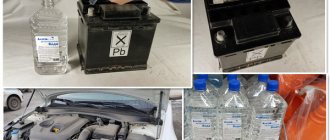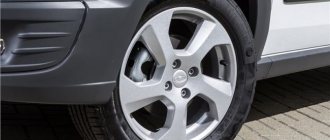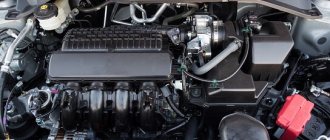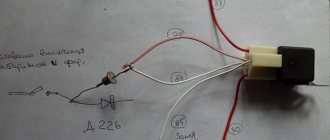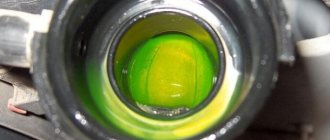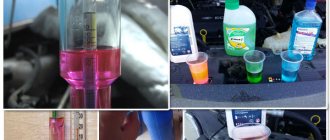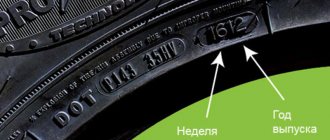There are always a lot of questions surrounding transport cooling systems. The most popular of them is: is it possible to add water instead of antifreeze? What kind of water is allowed to be poured: regular or distilled? What will happen if you pour it into a foreign car, and not into an old Lada? If the driver wants to do this to save money, then it is not worth it. It will not be possible to save on “water”, since it will be difficult and expensive to return the system to normal condition after such procedures. Let's consider this issue in more detail.
Why did they use water instead of antifreeze in Soviet times?
Remembering Soviet times, drivers claim that before cars always drove on water and did not break down. After a short period of time, refrigerant and antifreeze appeared on the automotive market. Gradually, water was stopped pouring into radiators and cooling systems. This turned out to be the right decision, since the use of special fluids increases the service life of the machine.
So why was it that water instead of antifreeze used to be common, but today it is forbidden to use it? In fact, the use of water is allowed, but only in extreme situations and for a short period of time. It’s not worth traveling with her “on a regular basis.”
During the Soviet era, cars were mostly filled with ordinary tap water, because other liquids simply did not exist. More precisely, antifreezes were made, but they were in very limited quantities and not available to everyone. As soon as antifreeze was invented in the West, antifreeze appeared in the USSR. More than 30 years have passed and now coolants are divided into categories and have different colors. They are also designed for different brands of cars, and are intended for a wide variety of systems.
Just 30 years ago, drivers poured boiling water in the morning and drained it in the evening. Now almost no one does this, but the method still remains in the memory of many people of Soviet origin.
Is it possible to mix antifreeze with water?
Water instead of antifreeze is not the best option. Can antifreeze be mixed with water? Experts strongly advise against doing this. This option is allowed only for propylene glycol antifreeze with a crystallization temperature of around -65 degrees.
This composition can be diluted with distilled water in a ratio of 1 to 1 (in this case, the freezing point of the resulting coolant will be around -20 degrees). But it is also recommended to refrain from such mixing (the exception is if such procedures are allowed by the antifreeze manufacturer, as indicated in its instructions).
It is strictly forbidden to mix ethylene glycol antifreeze with water, since when its original chemical composition changes, it loses most of its properties (optimal viscosity, heat transfer, detergent properties, corrosion protection). And because of this, the foaming process is activated (it is not so easy to wash the cooling system of foam later).
Adding water is allowed in the only case - this is an emergency need to restore the nominal level of coolant in the expansion tank . Simply put, if a significant leak occurs right on the road and the driver just needs to drive to the nearest service station. After refilling the water, all the liquid must subsequently be drained and new antifreeze added (after the leak has been eliminated).
Cooling system functions
Before you figure it out, you can add water instead of antifreeze; it’s worth remembering why a cooling system is needed in the first place.
Its main option is to remove excess heat from the engine. If this does not happen, the motor will overheat so much that it will stop functioning. Special fluids increase the engine's resources several times.
A special pump, which is located on a belt drive from the crankshaft, is called a pump. It is this part that prevents liquid from stagnating. It also prevents the refrigerant from boiling.
A radiator in a car is designed to dissipate excess heat. It can be basic and “from the stove”. The latter helps keep you warm in winter. Thus, we can say that the machine does not care which liquid will help it remove and dissipate heat. The car needs the system to work smoothly.
As for ordinary water, its heat capacity is 4.2 kJ. For refrigerants this figure is about 3.5 kJ. It seems that water can actually remove heat more efficiently. But it has a lot of shortcomings.
Which antifreeze is better?
The main thing in antifreeze is the correct proportion of additives, which prevent corrosion, changes in the viscosity of the coolant, scale formation, and foaming. Therefore, you should simply use high-quality antifreeze from reputable manufacturers.
Which is better: propylene glycol or ethylene glycol? The difference between them in terms of performance characteristics is minimal. But propylene glycol is not produced in the Russian Federation, so it costs more.
So, is it possible to add water instead of antifreeze in the summer? Yes, the car will work normally. But the consequences of using such a coolant will definitely make themselves felt sooner or later. In the best case, scale will simply appear in the radiator; in the worst case, the corrosion process will be activated, which can only be stopped at an early stage by thoroughly flushing the engine cooling system.
It is not recommended to conduct such experiments; absolutely all car manufacturers indicate that it is necessary to use antifreeze (the brand is selected depending on environmental conditions).
Source
Is it worth pouring water into foreign cars?
Many drivers do not know whether distilled water instead of antifreeze will perform the same functions. This is especially of interest to owners of foreign cars.
It is safe to say that adding water for a short period of time is permitted. For example, for a couple of days. During this time, nothing will happen to the cooling system. Don't forget to drain the water at the end of the day, replacing it with high-quality antifreeze. If the action takes place in winter, then the water will freeze overnight, so it must be drained in any case.
You also need to remember that many foreign cars are equipped with special sensors that measure the density of the anti-freeze. If the driver fills with regular water, the motor will recognize this and will not start.
If a driver is on the road and his radiator begins to leak, and there are no auto shops nearby, then water is his salvation. In this situation, it is allowed to pour liquid (clean, without impurities or dirt).
When can I fill it?
However, anything can happen on the road, for example, a hose falls off, or the radiator leaks and antifreeze begins to leak out, the level drops! You can’t go on like this, you need to do something. We go to a regular supermarket, or even to the pump - we pour (purchase) water and pour it into our expansion tank without fear. This way, you will be able to make it to the service station, but after that, be sure to drain it, completely flush the system and fill in antifreeze - the one recommended for you.
In this case, this “filling” is justified! You can’t drive with an empty cooling system at all, either a tow truck, or as I indicated. You will prevent the engine from overheating and will make it to the car service normally. Of course, the most ideal thing is to find distilled water, but it is not always on hand.
Is it possible to fill with water on a permanent basis?
Plain water (unfiltered) poured from the tap has a negative effect on the internal system of the engine, since it consists of metals. Accordingly, water starts the corrosion process.
If rust does form, it will clog all possible passages and channels. The radiators will be the first to suffer, followed by the pump impeller. Leveling up will become “difficult.” All these consequences will cause the system to leak, and the car will constantly overheat.
Water flooded in winter has a risk of freezing. Turning into ice, it will rupture pipes and hoses. To prevent this, the driver will have to drain it daily. Compared to water, antifreeze has many advantages.
We list the main ones:
Anti-freeze has this name because it does not freeze in winter. This is a huge plus.
Refrigerants are substances that fight corrosion rather than create it. Coolants create a thin film on system parts that prevents rust. If rust spots have already appeared, then antifreeze blocks it. All these properties are available thanks to the additives contained in the composition.
Some models are made in such a way that they do not boil even at very high temperatures. They can withstand up to +150 Celsius.
The cost of liquids is not so high that it is worth saving on it. A five-liter canister can be purchased for 500 rubles or even cheaper.
The most interesting thing is that one canister lasts for at least a year, and at best for 2. I think there is no need to explain that a system clogged with rust is not worth the 500 rubles.
Distilled water
If you want, it is recommended to dilute the antifreeze concentrate ; it can be poured in a 50/50 ratio. YES and in the short term, it is also desirable for filling (I mean getting to the service station).
The thing is that distilled liquid is just H2O without any impurities (salts, etc.) that can settle in the car’s cooling system. Therefore, it is used to dilute antifreeze and antifreeze.
However, again, it’s clean, you can’t fill it, it will cause all the disadvantages that I listed above, unless there is scale! And so it oxidizes the walls, freezes, and boils beautifully. So you can't!
That’s actually the whole answer, if you compare it with old engines, which were flooded and essentially weren’t afraid, so they were repaired every year, or a maximum of two years. Back then the oils were different, there was no antifreeze, and in general the technology was, to put it mildly, far from ideal.
My late grandfather once told me - if back then those engines had oils and fluids like they do now, we would have built more! So, the people were different, they thought about the country, and not about their pockets as they do now.
Source
Did you like the article? Subscribe to the channel to stay up to date with the most interesting materials
2
Let's imagine a situation: the coolant level in the tank is less than nominal and you need to add antifreeze. Is it possible to add water in this case or mix antifreeze with water?
IN WHAT CASES CAN WATER AND ANTIFREEZE BE MIXED?
If we talk about the manufacturer’s recommendations, they strictly prohibit mixing antifreeze and water. This is explained by the fact that antifreeze contains appropriate additives that have a beneficial effect on the cooling system, namely, they have good lubricating and cooling abilities.
Ordinary water will cope with engine cooling, but how does it affect engine parts? On modern cars, cooling system parts are made of aluminum alloys and hard water can corrode them, which over time will lead to corrosion. In addition, the water in the cooling system passes through the thin holes of the radiator, which over time can become clogged and lead to constant overheating of the engine.
If you pour water into the cooling system instead of antifreeze, do so only at your own peril and risk. If old cars are still tolerant of this, then on modern foreign cars this can lead to problems.
You can only fill with distilled water (sold in auto stores), and ordinary tap water is prohibited in any case, because... it can damage engine parts and its cooling system.
Misconceptions
It is clear that it is better not to add water in winter, but is it possible to add water instead of antifreeze in summer? This question also haunts many drivers.
Many people think that water will not be able to cool the system properly because it will immediately boil. For those who don’t know, boiling occurs at +100 degrees Celsius. Current engines operate at +110 and +120. Water is simply contraindicated for them.
But there is a big but in this situation. In fact, boiling occurs differently under different conditions. If you increase the pressure, the liquid will begin to boil only at +110 or + 120 degrees. The car cooling system has a closed structure with pressure. It is 1.2 - 1.4 ATM, and boiling at 110 degrees occurs only at a pressure of 1.5 ATM. This means that the water is also suitable for hot engines.
As for distilled water, it contains no impurities or salts compared to ordinary water. It is quite clean and one might say neutral. Many people think that they can certainly fill it in without fear of any consequences. However, it is not. After adding water to the internal combustion engine, it will instantly react with metal elements. It will also immediately become dirty and turn into ordinary water.
A canister of distilled water has the same cost as antifreeze or antifreeze. It would be more logical to purchase them.
Pros and cons of this approach
Now, to be honest, you can also pour water into the system, why not! Even from the tap! After all, water is an excellent carrier that can remove excess heat. Nothing will happen to your car instantly, but I think you can drive for about six months, but then problems will start.
- Water is everywhere, in every tap
- It's free
- Combats heat dissipation tolerably
The thing is that ordinary water is not only H2O, it also contains all sorts of salts and other impurities. Also, water does not protect metals from oxidation, rust and subsequent destruction. What else I would like to note is that now the engines of modern cars operate at temperatures above 100 degrees Celsius, for example 105 - 110, and as you know, water boils at 100, so even a working engine will boil and steam. What will this ultimately cause?
Minuses:
- The most harmless thing is scale on the walls of the pipes, a white coating like in any kettle in our apartment.
- The engine, despite the fact that it is made of aluminum alloys, and the cooling system is often made of copper and brass. It will begin to oxidize and rust, especially metal structural elements will be susceptible to this.
- Elements such as the pump, thermostat, metal adapters, etc. will be destroyed, because they are all made of metal.
- Since the water already boils at 100 degrees, air plugs form - there is a high probability that your pipes, radiators, and even the expansion tank itself will rupture; the plug may not save you.
- Do not forget that water freezes already at zero degrees, and at “-3, -4” there will be ice plugs in the system, they will simply rupture the pipes and can even damage the engine block.
As you can see, water is not at all ideal, and I would not pour it into modern cars.
How to return the cooling system to its normal state?
If the driver does encounter negative consequences from the water, he will have to return the system to its normal state as quickly as possible.
First you need to flush the system by warming up the engine a little, cooling it and draining the liquid. This is the sequence in which the procedure takes place. After this, the system is filled with coolant selected specifically for the car brand. The range includes different types of refrigerants. If the driver does not know which one is suitable for him, then it is worth asking the seller about it.

